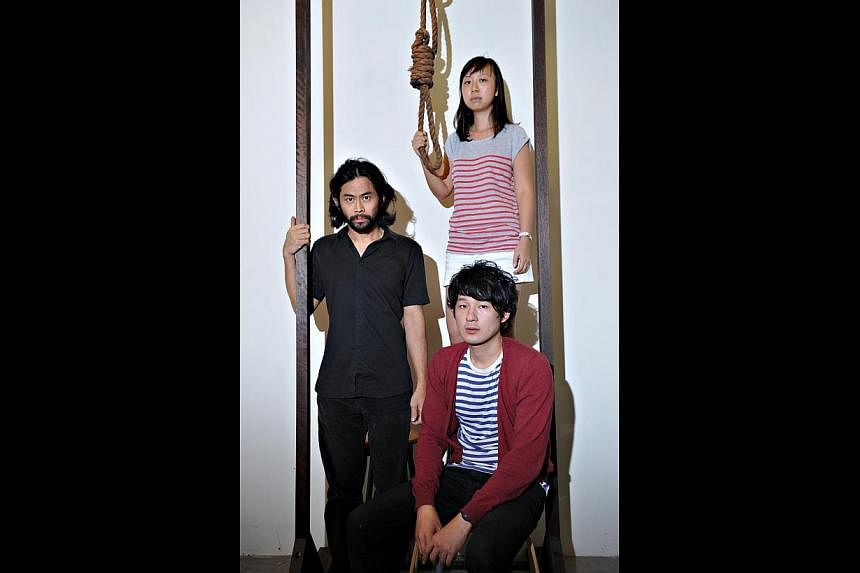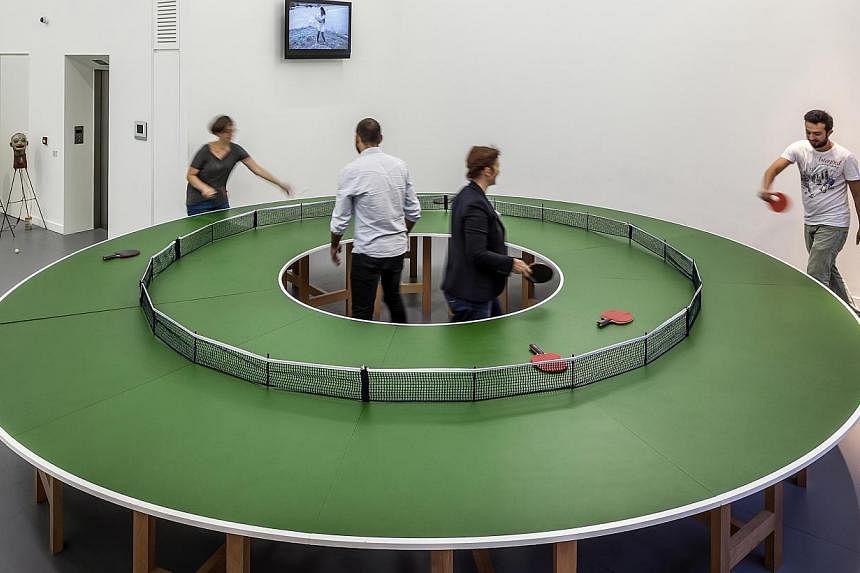After wowing Hong Kong in May at the premier contemporary art fair Art Basel, a doughnut-shaped ping-pong table by Singapore artist Lee Wen has been charming art lovers in Istanbul.
Arter, a contemporary art space in the cosmopolitan Turkish city, is hosting The Roving Eye: Contemporary Art From South-east Asia. Curated by Singapore-based Iola Lenzi, it is said to be the largest and most geographically ambitious curated contemporary South-east Asian exhibition in Europe to date.
Lee's Ping-Pong Go Round, an interactive installation where viewers can pick up the paddle, is among 40 works by 36 of South-east Asia's leading contemporary artists. They come from countries such as Singapore, Indonesia, Thailand, the Philippines, Myanmar, Cambodia, Vietnam and Malaysia.
Other Singapore artists represented in the exhibition - which drew 15,000 visitors in the opening weekend and runs till January - are ceramicist and performance artist Jason Lim, photographer Tay Wei Leng and the art collective Vertical Submarine.
The Turkish organisers say the interactive element of Lee's piece has been a huge draw. The artist, a 2005 Cultural Medallion recipient, is happy to see his work travel. The work, first presented in 1998 in Melbourne, Australia, has travelled to numerous cities such as Bangkok, Kuala Lumpur and Suzhou.
Turkish novelist and essayist Kaya Genc, one of those who saw the exhibition last week, singles out the piece as a highlight, pointing out that "high school students seized paddles when I was visiting... but their attempts at playing ping-pong at the heart of Istiklal Avenue failed. Lee Wen makes clear that it is the table that defines the game and one simply cannot play ping-pong on a doughnut-shaped table, although it is fun to try".
Arter is one of several art galleries in Istiklal Avenue, a bustling pedestrianised thoroughfare.
As well as introducing works from the region, the show offers critical insights into today's South-east Asian culture. It features installations, videos, sound pieces, photography and performances, a number of which were especially commissioned for the exhibition, and places emphasis on works that embrace experience, interactivity and participation. Performance art has been a critical part of it too.
Three performances took place on the opening day, including the seminal five-hour I Love You by Indonesian performance artist Melati Suryodarmo, a piece originally performed in Barcelona in 2007. In it, she explores the burdens of love by grasping a glass piece weighing 32kg. She repeatedly says the words "I love you", with the emotion bordering on fatigue by the end of the piece.
Lenzi says the exhibition took over three years to put together. She had met the head of Arter, Melih Fereli, at the Art Hong Kong fair in May 2011 through a mutual friend.
"Comparing notes on the contemporary art of Turkey and South-east Asia, we discovered shared themes and concerns in terms of art historical discourse. Melih knew my approach to regional art from my 2011 Singapore Art Museum South-east Asian survey Negotiating Home, History And Nation."
Lenzi travelled to Istanbul in 2012 to pitch the exhibition concept and it took off from there.
She says: "I was offered the entire building as my canvas, along with a generous multi-essay catalogue for documenting the exhibition. I was given carte blanche in terms of choice of works and artists, a dream proposition for a curator, as well as a commissioning budget.
"It was the best of both worlds, a solid and prestigious institutional platform for the artists, at the border between Asian and Europe, and a free hand to commission new site-specific works as one does in smaller venues," she said.
She adds that the response has been excellent. Visitors have included not just artists, art collectors, curators and historians but also the public.
Singapore works have been getting a lot of attention and several artists featured say the cultural exchange and exposure have been invaluable.
Vertical Submarine's installation Mirrors And Copulations 2014, for instance, has been talked about for its play on optical illusion. Among other things, it explores how we look at an image or a scene. When viewers step into a room, they are tricked into believing the window in the room is a mirror. But there is a lot more to it. Everything except the viewer's own image is a play on reflection.
Responding on behalf of the collective, artist Justin Loke says: "It is always challenging to be in a major South-east Asian group show, like a soccer team playing an away game on a regional or international level, but yet, as a collective, we often cheat by outnumbering others."
He says the difficulty in presenting work overseas "lies not only with funding but also logistics, suitability of venues and the kind of overseas collaborators". In the case of this show, however, they laud Lenzi for her "strong curatorial direction, advice during the process, and the help of a very professional team in Istanbul".
Ahmet Rustem Ekici, a Turkish architect and television set designer, says there were many lessons he took from the works he saw.
"The world is not like a standard ping-pong game played between two people on opposite sides of a rectangular table. The rules of the games have shifted. Today, action and information are more interactive than ever. The art I saw seems to question whether it is the rules and boundaries that keep us together, or is it the fact that we are together that defines the boundaries and the rules," he says.
The Roving Eye runs at Arter, Beyoglu, Istiklal Caddesi No. 211, Istanbul, until Jan 4. Admission is free.


